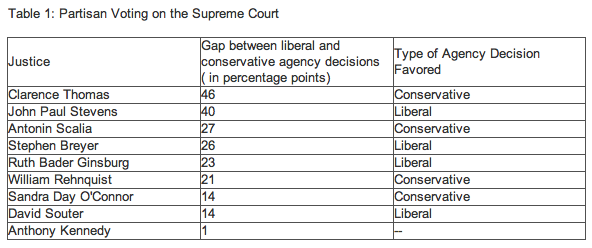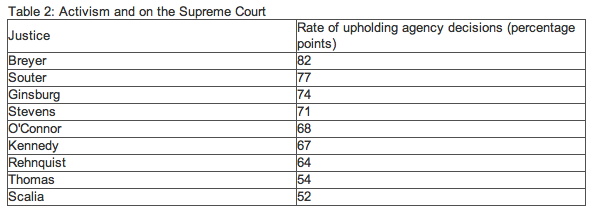
This originally appeared on the Washington Independent.
Who are the real activists on the U.S. Supreme Court? Do Republican appointees differ from Democratic appointees? How much? Are federal judges political?
I have been studying these issues with several colleagues, including Thomas Miles, an economist and lawyer at the University of Chicago Law School, for a number of years now. One big question: Do judges show a political bias? We also wanted to see what any bias might tell us about how judges might rule in the future -- under, for example, an Obama or McCain administration.
We catalogued thousands of judicial decisions -- well over 20,000 -- to analyze this. We looked for partisan bias by studying whether and when judges vote to uphold decisions of federal agencies, in areas including environmental protection, labor, telecommunications, discrimination and occupational safety.
We investigated which members of the Supreme Court are the most partisan -- in that they are more likely to vote in favor of conservative agency decisions than liberal ones. (Because Chief Justice John Roberts and Justice Samuel Alito have been on the court only a short time, we did not include them because we had too little data.) We wanted to see if some justices are more political in their voting patterns than others - and also learn something about how future administrations are likely to fare in the Supreme Court.
We used a simple test to decide whether an agency's decision should be counted as liberal or conservative. If a decision was challenged by a public-interest group, like the Sierra Club or Environmental Defense, we counted it as conservative. If it was challenged by a corporation, like Exxon or General Motors, we counted it as liberal.
We used this method because the relevant question is not whether an agency's decision is liberal or conservative in the abstract -- it is how and why that decision is challenged in its context. In addition, though we had many students working on this, we read every decision ourselves, making adjustments when our method led to errors.
We wanted to know: Is it true that liberal justices are more partisan than conservatives? Who is the most partisan member of the Supreme Court? Who the most neutral?
Our answers: Justice Clarence Thomas wins the Partisanship Award. Justice Anthony M. Kennedy wins the Neutrality Award.
Here are the results:

This information does not tell us everything we need to know. Thomas shows the strongest partisan bias, but is he also an activist? Does he vote to strike down agency decisions at a high rate? To test for judicial activism and judicial restraint, we examined all the data to find which justices are most likely to strike down agency decisions.
It turns out that Breyer wins the award for Judicial Restraint. Surprisingly, the award for Judicial Activism goes to . . . Justice Scalia. Here are the results:

While the Supreme Court gets the most attention, the lower courts are also important in determining the meaning of national law and shaping national policy. To analyze their behavior, we decided to focus on how Republican and Democratic appointees approach the decisions of the Environmental Protection Agency and the National Labor Relations Board.
We asked whether Republican appointees are less likely to vote to uphold liberal decisions from those agencies, than conservative ones; and whether Democratic appointees show the opposite pattern. Here, too, we defined agency decisions as liberal or conservative depending on who challenged them. If a labor union or an environmental group made the challenge, for example, the decision was labeled conservative. If a company challenged a labor ruling or an environmental regulation, the decision was characterized as liberal. We again read all the decisions here to test our characterizations.
The answer: Partisan voting is pervasive on the lower federal courts.
When the agency's decision is conservative, Republican appointees are far more likely to vote to uphold it than are Democratic appointees. Democratic appointees show the same bias: When the agency's decision is liberal, Democratic appointees are much more likely to vote to uphold it than are Republican appointees.
Republican appointees vote to uphold liberal agency decisions at a significantly lower rate than conservative agency decisions. Democratic appointees vote to uphold liberal agency decisions at a significantly higher rate than conservative agency decisions.
This evidence offers three important lessons.
First, widespread conservative complaints about "liberal judicial activism" should be taken with many grains of salt. If we ask how often the justices vote to strike down agency decisions, Scalia and Thomas, the most conservative members of the Supreme Court, show the most activist voting patterns. By contrast, the justices commonly described as "liberal" are the least activist.
Of course, there are other measures of what makes a judge "activist," and I do not claim that our method cannot be challenged, but it is useful to offer some statistical tests, which can ensure that critics are not building their conclusions into their definitions.
Second, partisan voting is a serious problem in the federal judiciary. If the EPA issues a regulation that is aggressive in cleaning the air, or if the National Labor Relations Board resolves a dispute in favor of a union, a panel that consists solely of Republican appointees is unusually inclined to strike it down. That's indefensible. No one should approve of a situation in which the fate of an environmental regulation depends on whether a lower court panel consists of one, two or three Republican appointees.
Third and perhaps most important, federal agencies in an Obama or McCain administration are likely to make a number of decisions that are more liberal than those of the Bush administration. Many decisions will ultimately be challenged in federal court -- and the Republican-appointed judges who dominate the federal bench could well prove to be a big obstacle. On the Supreme Court, for example, Scalia and Thomas might be joined, much of the time, by Roberts and Alito. On key occasions, Kennedy might probably join them as well.
The lower federal courts could prove an even more serious barrier. Those courts have been stocked with appointees of Presidents Ronald Reagan, George H.W. Bush and George W. Bush. The voting behavior of appointees has been clear: They show a distinctive tendency to strike down agency decisions that do not follow a conservative line.
Here, then, is a major warning for the next administration - and a potential problem for democracy itself.
Cass R. Sunstein is Felix Frankfurter Professor of Law at Harvard Law School, as of Aug. 1. He will be the Harry Kalven Visiting Professor at University of Chicago Law School in January 2009. His most recent book, which he co-wrote with Richard Thaler, is "Nudge: Improving Decisions about Health, Wealth, and Happiness." His books include "Are Judges Political? An Empirical Analysis of the Federal Judiciary" and "The Second Bill of Rights: FDR's Unfinished Revolution and Why We Need It More Than Ever."
This originally appeared on the Washington Independent.